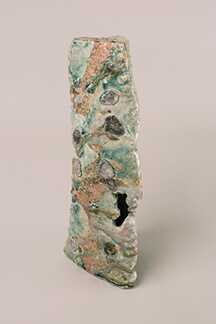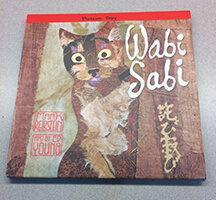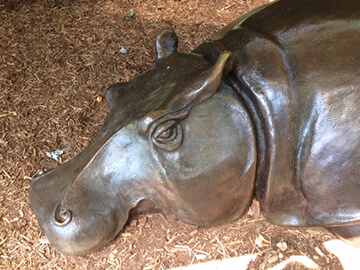With a background in sociology and comparative religious studies, I’ve done my share of navel-gazing; with a career in gallery engagement, artwork-gazing is a daily ritual. Imagine my bliss when an art exhibition encompasses more than a process, medium, or movement and extends to a worldview.

Atarashi Kanji, “Iga Vase,” 2009, Iga ware, glazed stoneware
My task is to research artworks on view to reveal and share points of entry and engagement for visitors of all ages and stages. To quote Asian art historian Meher McArthur who curated Contemporary Japanese Ceramics: Nature, Tradition & Innovation for tour, “ . . . this exhibition showcases ceramic objects of unsurpassed beauty made for everyday use.”
Seems straightforward: rustic wares made for and used in tea ceremonies comprise tea bowls, flower vases, and platters (and a few sake vessels to broaden the experience).
Seems simple.
As a curator of education (not an art historian) who creates a variety of experiences for four different exhibitions each year, my initial research is pragmatic and deliberate, focused on medium, process, and subject. Invariably, the facts gleaned are stories reaped; I’ve discovered that for me, sharing art is about the story. While preparing for in-gallery discussions, a myriad of cultural touchpoints leap at me and beg inclusion. My notes on the current exhibition are littered with references to Zen Buddhism, art of the people, austerity, mindfulness, aestheticized hospitality, the warrior elite, Six Ancient Kilns, Shintoism, kami, master and student, ritual, spirit technique, monastics, living natural treasures, and tea masters.
Seems complex.
The essence of the exhibition is wabi sabi . . . the heartbeat of Japanese culture: refined rusticity and simplicity, impermanence, harmony in nature, and the beauty in imperfection and age.
I thrill at getting lost in the proverbial trees, but a thirty- to sixty-minute gallery experience requires that I find the forest. What’s the most direct and poetic means to this end? (Please excuse the trip into philosophy.) Illustrated children’s literature.
Wabi Sabi written by Mark Reibstein and illustrated by Caldecott Medal winner Ed Young was recommended to me by Shannon Pueschner, the Woodson Art Museum’s creative consultant. As excerpted on the cover, “using spare text and haiku” and told through the tale of Wabi Sabi, a little cat who desires to know the true meaning of her name, Reibstein and Young “illustrate the unique world view that is wabi sabi.”
When I first read the book, months before the artwork was installed, I enjoyed it. I learned, however, to truly appreciate and value the beautiful simplicity of the tale while strolling through the galleries in the hours before the exhibition opened. It prompted me to reflect on other children’s illustrated literature that succinctly captures the complex: Old Turtle, The Three Questions, and Zen Shorts. As if to further elucidate my point, during Treasuring Memories – a hands-on art program hosted annually at the Woodson Art Museum for those of all ages grieving a loved one – Amy Kitsembel, bereavement coordinator at Aspirus Comfort Care and Hospice Services, read The Next Place.
Begin your Japanese ceramics experience in Art Park, the Museum’s interactive family gallery. Settle into Reading Hills, peruse Wabi Sabi, and engage in the interactive activities. Then, view and more deeply appreciate the simply exquisite art in the galleries.

Burt Brent’s “The Heavyweight” (detail) in the sculpture garden
Also do some nasal-gazing in the sculpture garden as I had the pleasure of doing with five classes of tots and babies last week.
Visit often and looking ahead to next spring, plan to visit when the Woodson Art Museum continues its commitment to exhibiting the best of children’s illustrated literature with the work of Caldecott-winning illustrator and author, Eric Rohmann.




